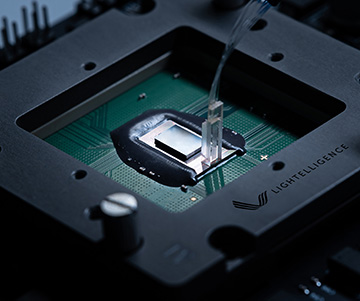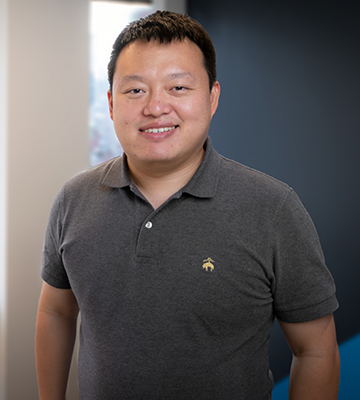
The PACE chip. [Image: Courtesy of Lightelligence]
Lightelligence, an early-stage US-based company focused on developing optical computing hardware, has unveiled an integrated photonic–electronic platform that reportedly blazes through a specific class of “hard” computing problems at speeds hundreds of times faster than a conventional high-end electronic processor.
The platform—dubbed PACE (for Photonic Arithmetic Computing Engine)—achieves its performance edge by seeking an optimal combination of optical and electronic elements. At the heart of the system is a photonic integrated circuit (PIC) that rapidly and energy-efficiently performs the repeated, processing-intensive matrix multiplications that are a key bottleneck in many AI-flavored computing problems. That PIC is tightly packaged, in a small 3D stack, with an electronic integrated circuit (EIC) to handle other, less power-hungry tasks.
The company believes that the PACE demo clearly shows “the advantages of optical computing over traditional paradigms” in certain types of problems, particularly ones relevant to AI. Lightelligence plans to build on the PACE platform to develop and release, sometime next year, a pilot AI accelerator product with a number of key partners in finance and cloud computing.
MIT spinout
Lightelligence began in 2018, in the wake of a much-discussed 2017 Nature Photonics paper on coherent nanophotonic circuits by a group at the Massachusetts Institute of Technology (MIT). The company was spun out of MIT shortly thereafter to commercialize the technology, with the paper’s lead author, Yichen Shen, as CEO. (A competing company working on AI accelerator chips, Lightmatter, was started in 2017 by a coauthor on the same paper, Nicholas Harris.)

Lightelligence cofounder and president Spencer Powers. [Image: Courtesy of Lightelligence]
Shen teamed up with a number of other cofounders, including Huaiyu Meng, an MIT engineering Ph.D., who took on the role of CTO, and Spencer Powers, an alum of the university’s Sloan School of Management, who is now the president of Lightelligence. Another cofounder was Shen’s faculty advisor, MIT professor Marin Soljačić. Since its founding, Lightelligence has grown from a staff of 15 to more than 150 employees, according to Powers, and has raised more than US$100 million in capital.
Designing photonic ASICs
Lightelligence has focused squarely on the market to accelerate AI computing—particularly in contexts such as cloud data centers, but also for on-premises opportunities in industries such as banking and “smart” retail. “Since around 2012, 2013, the demand for AI compute has doubled every 3.4 months,” Powers told OPN. “So it’s basically growing much faster than the pace of electronics improving.”
The company hopes to meet that demand by developing application-specific integrated circuits (ASICs) that can leverage the unique advantages of light-based computing—in power consumption, efficiency and latency—for the computationally intense matrix multiplications at the heart of AI and deep-learning algorithms. In 2019, it revealed its first prototype, fully integrated optoelectronic AI accelerator, Comet, and demonstrated the chip’s mojo using the MNIST, a benchmark machine-learning model focused on recognizing handwritten characters.
Picking up the PACE
PACE, developed in the two years since Comet was unveiled, has leapfrogged the earlier system in a variety of metrics, according to Lightelligence cofounder Meng.
“One achievement we’re very proud of is that we have now demonstrated … how we integrate a large number of photonic and electronic devices all together,” Meng told OPN. “In Comet, it’s about 100 devices. In PACE, we managed to integrate more than 12,000 devices.” He adds that PACE also ratchets up the chip’s clock speed to a gigahertz, versus just 100 kilohertz in Comet.

Lightelligence cofounder and CTO Huaiyu Meng. [Image: Courtesy of Lightelligence]
“If we combine these two numbers, that means we are actually able to provide a computation power … close to 1 million times bigger than our previous generation,” unveiled just two years earlier, Meng said. He attributes the progress to the company’s codesign process, which aims at a harmonious marriage between the electronic and optical components. “That is actually something that hasn’t been done in the industry yet,” Meng maintains.
Speeding through NP-complete problems
To demonstrate PACE’s capabilities, Lightelligence chose a use case from outside of the realm of AI and deep learning: the solution of a class of so-called NP-complete problems. These are “hard” computing problems, in that they are not known to be solvable by algorithms that run in polynomial time (that is, as a polynomial function of the problem size). Yet they have a variety of potential applications in bioinformatics, scheduling, circuit design and materials design, according to Lightelligence.
In its recent demo of the PACE system, Lightelligence leveraged an algorithm, published in 2019 by a group of MIT researchers including company cofounder Shen, for solving a class of NP-complete problems called Ising problems. The approach is based on a tight loop combining repeated matrix multiplication in the optical domain with a computationally simpler nonlinear optoelectronic step, the result of which is fed back into the optical matrix multiplier for the next computational round.
Perhaps not surprisingly, the team found that this algorithm—which aligns rather closely with the architecture of the PACE system—ran hundreds of times faster on the PACE platform than on state-of-the-art processing units such as the NVIDIA RTX 3080 GPU. But it also, according to the company, runs some 25 times faster than competing algorithms for the same class of problems. And, with light handling the heavy lifting of repeated matrix multiplications, it should carry substantial energy savings over all-electronic approaches.
The next steps
Company cofounder and CEO Yichen Shen summed up his view of the demo’s significance in a press release accompanying the PACE reveal. “PACE proves,” said Shen, “that our integration of photonic chips and electronic chips in a small 3D stack does what we’ve intended—deliver unprecedented computational power in a platform that’s compact, low-power, low-temperature and not gated by Moore’s Law.”
According to cofounder and president Powers, Lightelligence plans to follow up the successful demo of PACE by releasing a pilot AI accelerator product, packaged on a PCIe board, next year. “It will run general AI workflows and be at commercial-grade performance,” he said, adding that the immediate aim was not volume production but a limited run working with some specific partners. That experience, he said, would be used to bring a future AI accelerator product to a broader market in 2023.
